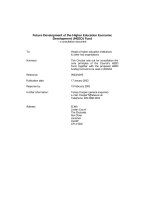Place development of channel systems
Bạn đang xem bản rút gọn của tài liệu. Xem và tải ngay bản đầy đủ của tài liệu tại đây (379.2 KB, 16 trang )
Place & Development of Channel
Systems
Place: making goods & services available in the right quantities and
locations, when customers want them
Selecting the channel of distribution
Depending on:
DISTANCE
PERISHABILITY
SPECIAL HANDLING
NUMBER OF CUSTOMERS
TRANSPORTATION
STORAGE
Channel of distribution: any firms or individuals who participate in the flow
of goods from producer to final consumer
Direct Channel system :
Firms distribute directly to the final consumers , they perform all activities
without intermediaries because :
They want to control the whole marketing job.(products, price, service)
They can serve target customers at a lower cost or do the work more
effectively than intermediaries.
Direct channel is common with business customers & services.
In direct contact with customers, firms are more aware of changes in
customer attitudes.
A firm may have to go direct if suitable intermediaries are not available
or will not cooperate.
In Direct Channel:
Producer sells & distributes its products to customers; therefore the firm is
responsible for : warehouse
equipment
transport
personnel
needed to complete distribution activities.
Indirect channel: use intermediaries to distribute
goods& services
As consumers are spread throughout many geographic areas & They shop
for certain products at specific places.
As direct distribution requires a big investment in facilities, people, IT.
Firms have to rely on the indirect channel
-Intermediaries may reduce a producer’s output & carrying it in inventory
until it’s sold.
-Intermediaries can help producers serve customer’s needs better at
lower costs.
Types of Channel Intermediaries
Wholesalers buy goods from producers & resell them, wholesalers
receive , take title to goods, store them in their own warehouses, and
ships them.
Agents & brokers facilitate the sale of a product from producer to end
user. They get a fee or commission based on sales volume.
Retailer sells goods mainly to consumers.
Channel Structures
A product can take many routes to reach its consumer. Marketers search for
the most efficient channel from many alternatives available.
CHANNELS FOR CONSUMER PRODUCTS
&
CHANNELS FOR B2B &INDUSTRIAL PRODUCTS
CHANNELS FOR CONSUMER PRODUCTS
CHANNELS FOR B2B & INDUSTRIAL PRODUCTS
Channel Strategy Decisions
Factors affecting channel choice
Market Factors
-Target customer considerations
( who? What? Where/when? How?)
- Geographic location& Size of the market
- Industrial customers vs Individual consumers
Product factors
What products sell better through direct sales force.
PLC in choosing a marketing channel.
Producer factors
- Big – Medium – small
Levels of Distribution Intensity:
intensive distribution/selective distribution/ exclusive
distribution
Intensive distribution strategy : form of distribution aimed at having a
product available in every outlet at which target customers might want to
buy it.
Selective distribution strategy: form of distribution achieved by
screening dealers to eliminate all but a few in any single area.
Exclusive distribution strategy : form of distribution that establishes one
or a few dealers within a given area.









